Organizational Change: Leadership and Management Report
VerifiedAdded on 2022/12/14
|16
|5301
|162
Report
AI Summary
This report provides a detailed analysis of organizational change and its impact on leadership, team dynamics, and individual behavior. It begins with an introduction defining organizational change and outlining its various types, including structural, strategic, and people-related changes. The report then compares the impacts of organizational changes at Tesco and Sainsbury, focusing on the introduction of Club cards at Tesco and job cuts at Sainsbury. It examines the effects of internal and external drivers of change on leadership styles, team dynamics, and individual behavior, offering insights into how these drivers shape organizational outcomes. Furthermore, the report explores strategies for minimizing the negative impacts of change on organizational behavior, including discussions of barriers to change and their influence on leadership decision-making. Different situational leadership approaches for dealing with organizational changes are also discussed, providing practical recommendations for effective change management. The conclusion summarizes the key findings and emphasizes the importance of proactive leadership in navigating organizational change.
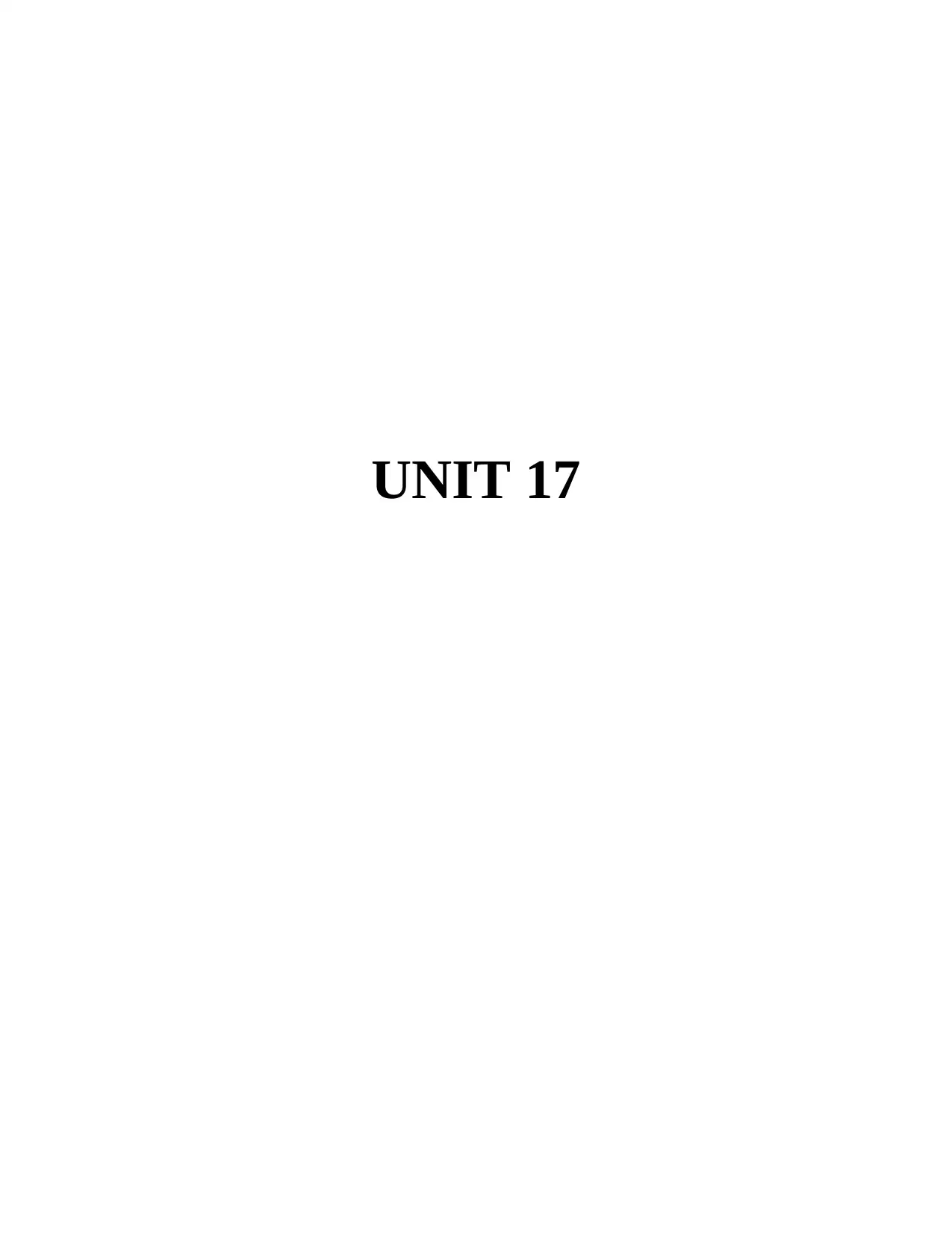
UNIT 17
Paraphrase This Document
Need a fresh take? Get an instant paraphrase of this document with our AI Paraphraser
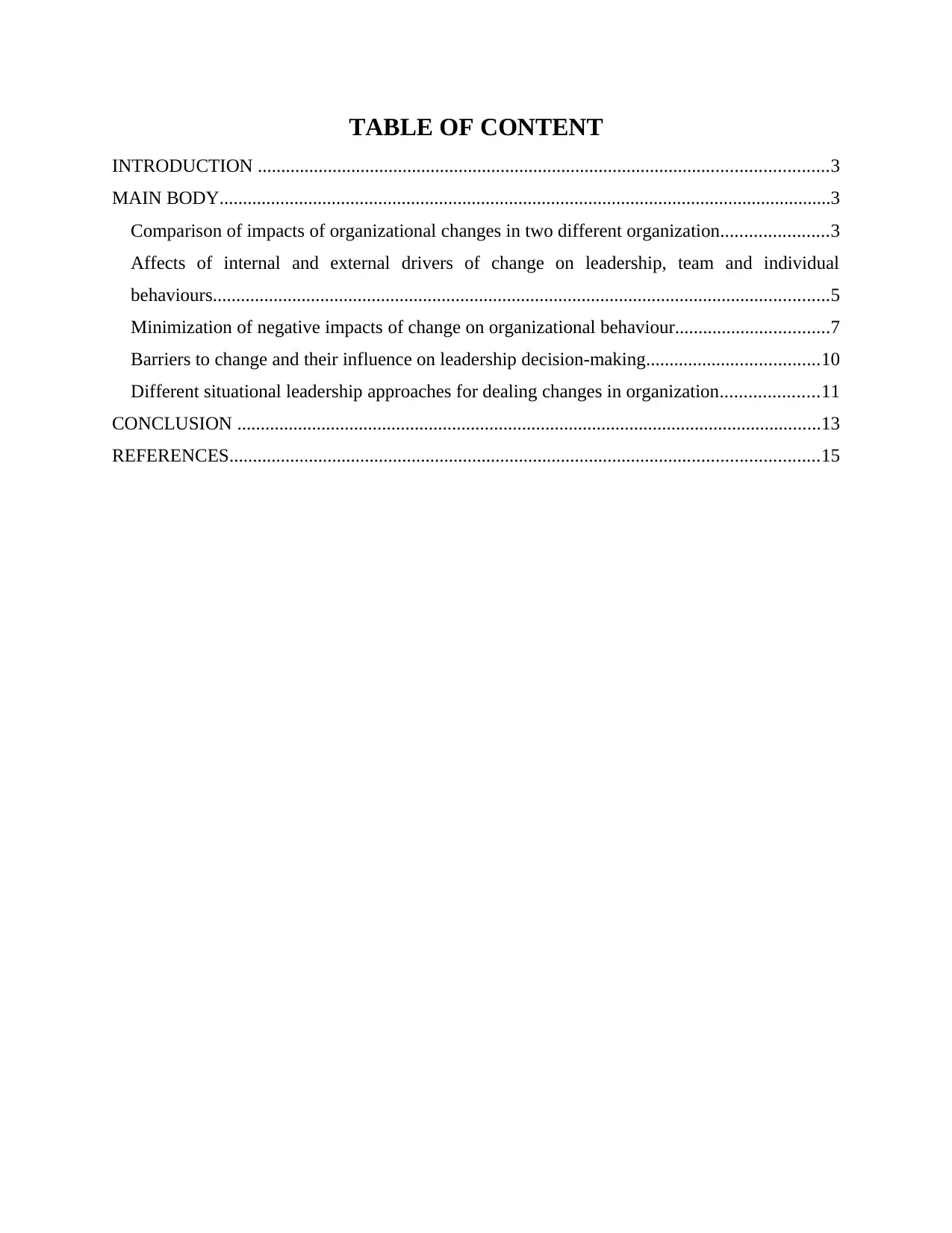
TABLE OF CONTENT
INTRODUCTION ..........................................................................................................................3
MAIN BODY...................................................................................................................................3
Comparison of impacts of organizational changes in two different organization.......................3
Affects of internal and external drivers of change on leadership, team and individual
behaviours....................................................................................................................................5
Minimization of negative impacts of change on organizational behaviour.................................7
Barriers to change and their influence on leadership decision-making.....................................10
Different situational leadership approaches for dealing changes in organization.....................11
CONCLUSION .............................................................................................................................13
REFERENCES..............................................................................................................................15
INTRODUCTION ..........................................................................................................................3
MAIN BODY...................................................................................................................................3
Comparison of impacts of organizational changes in two different organization.......................3
Affects of internal and external drivers of change on leadership, team and individual
behaviours....................................................................................................................................5
Minimization of negative impacts of change on organizational behaviour.................................7
Barriers to change and their influence on leadership decision-making.....................................10
Different situational leadership approaches for dealing changes in organization.....................11
CONCLUSION .............................................................................................................................13
REFERENCES..............................................................................................................................15
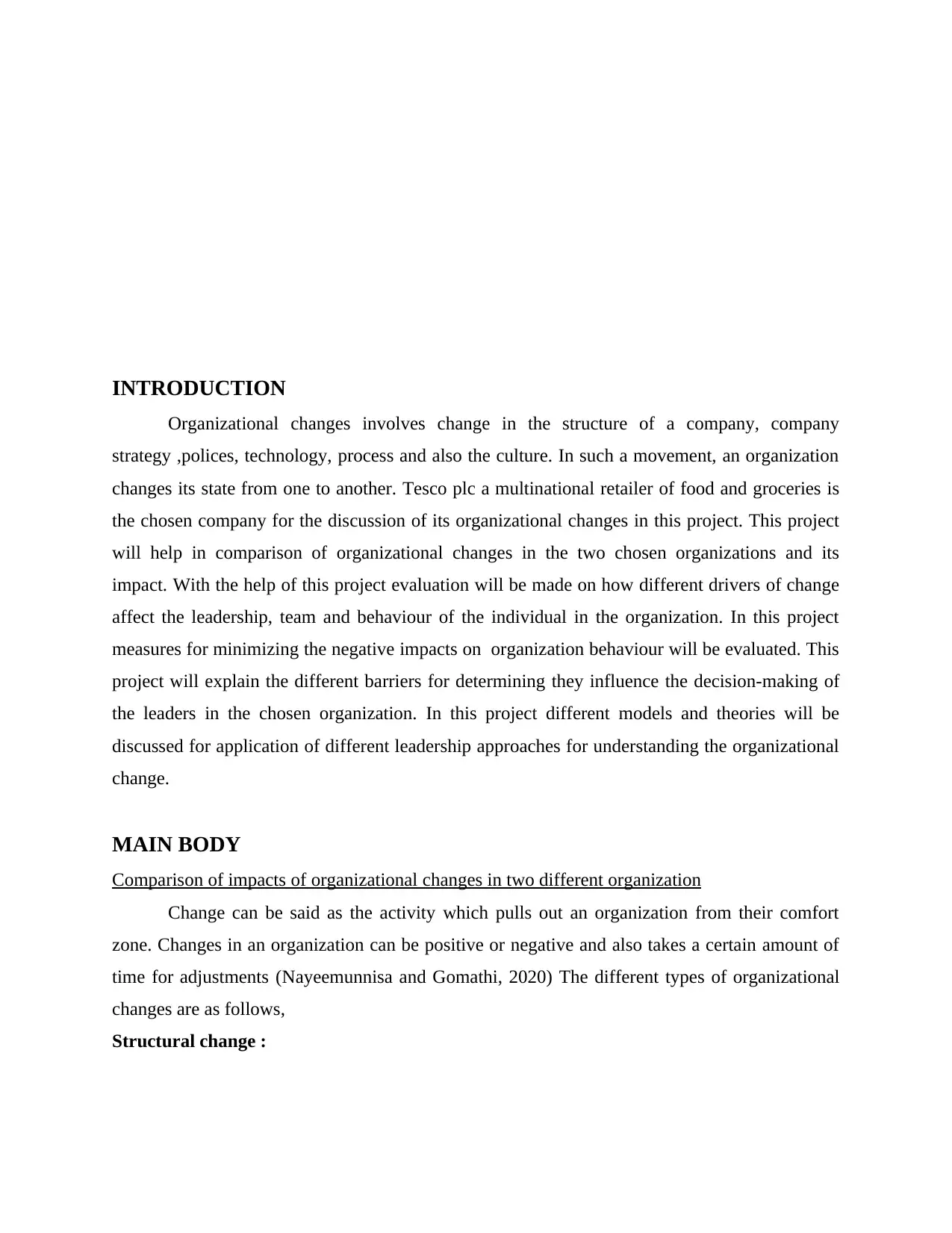
INTRODUCTION
Organizational changes involves change in the structure of a company, company
strategy ,polices, technology, process and also the culture. In such a movement, an organization
changes its state from one to another. Tesco plc a multinational retailer of food and groceries is
the chosen company for the discussion of its organizational changes in this project. This project
will help in comparison of organizational changes in the two chosen organizations and its
impact. With the help of this project evaluation will be made on how different drivers of change
affect the leadership, team and behaviour of the individual in the organization. In this project
measures for minimizing the negative impacts on organization behaviour will be evaluated. This
project will explain the different barriers for determining they influence the decision-making of
the leaders in the chosen organization. In this project different models and theories will be
discussed for application of different leadership approaches for understanding the organizational
change.
MAIN BODY
Comparison of impacts of organizational changes in two different organization
Change can be said as the activity which pulls out an organization from their comfort
zone. Changes in an organization can be positive or negative and also takes a certain amount of
time for adjustments (Nayeemunnisa and Gomathi, 2020) The different types of organizational
changes are as follows,
Structural change :
Organizational changes involves change in the structure of a company, company
strategy ,polices, technology, process and also the culture. In such a movement, an organization
changes its state from one to another. Tesco plc a multinational retailer of food and groceries is
the chosen company for the discussion of its organizational changes in this project. This project
will help in comparison of organizational changes in the two chosen organizations and its
impact. With the help of this project evaluation will be made on how different drivers of change
affect the leadership, team and behaviour of the individual in the organization. In this project
measures for minimizing the negative impacts on organization behaviour will be evaluated. This
project will explain the different barriers for determining they influence the decision-making of
the leaders in the chosen organization. In this project different models and theories will be
discussed for application of different leadership approaches for understanding the organizational
change.
MAIN BODY
Comparison of impacts of organizational changes in two different organization
Change can be said as the activity which pulls out an organization from their comfort
zone. Changes in an organization can be positive or negative and also takes a certain amount of
time for adjustments (Nayeemunnisa and Gomathi, 2020) The different types of organizational
changes are as follows,
Structural change :
⊘ This is a preview!⊘
Do you want full access?
Subscribe today to unlock all pages.

Trusted by 1+ million students worldwide
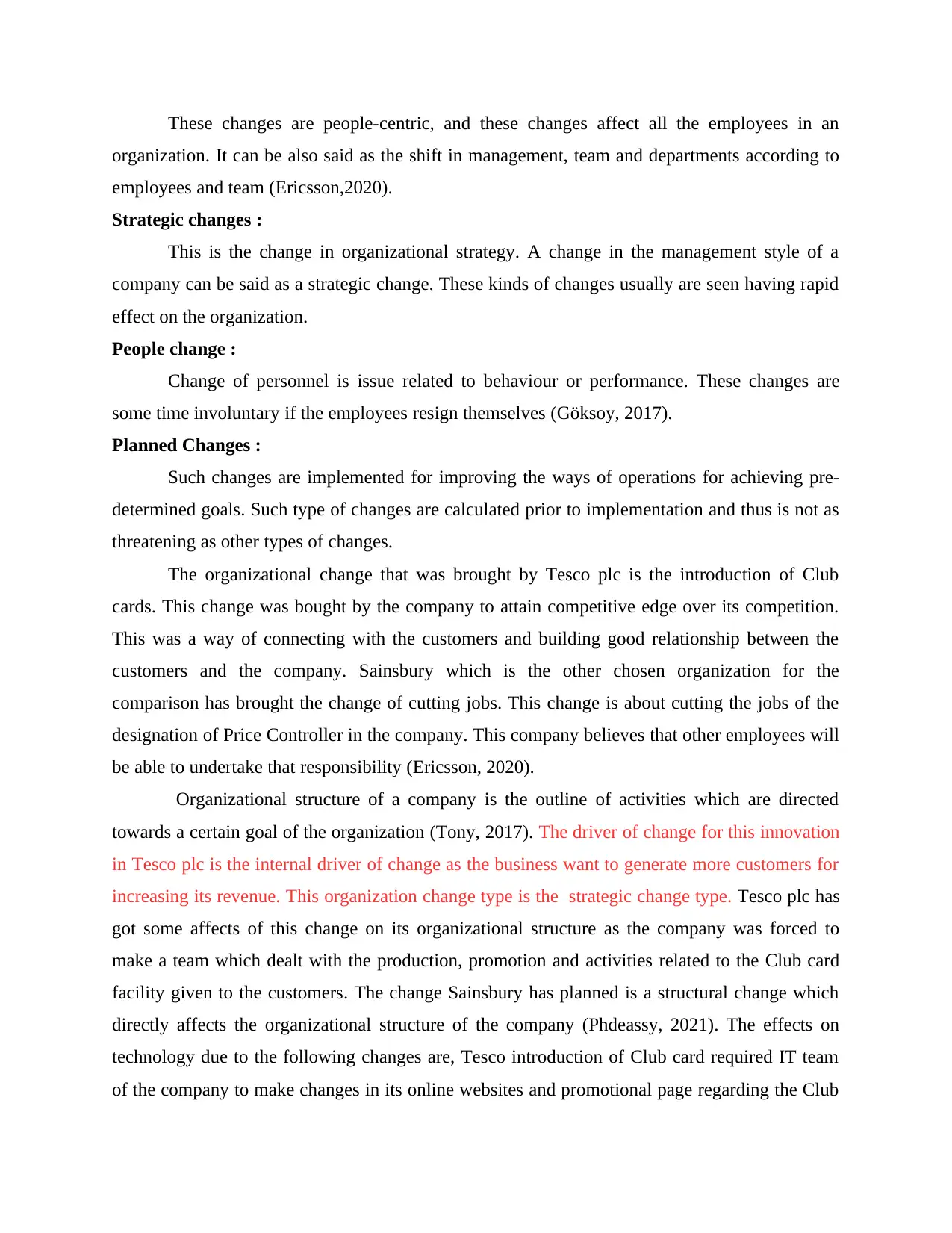
These changes are people-centric, and these changes affect all the employees in an
organization. It can be also said as the shift in management, team and departments according to
employees and team (Ericsson,2020).
Strategic changes :
This is the change in organizational strategy. A change in the management style of a
company can be said as a strategic change. These kinds of changes usually are seen having rapid
effect on the organization.
People change :
Change of personnel is issue related to behaviour or performance. These changes are
some time involuntary if the employees resign themselves (Göksoy, 2017).
Planned Changes :
Such changes are implemented for improving the ways of operations for achieving pre-
determined goals. Such type of changes are calculated prior to implementation and thus is not as
threatening as other types of changes.
The organizational change that was brought by Tesco plc is the introduction of Club
cards. This change was bought by the company to attain competitive edge over its competition.
This was a way of connecting with the customers and building good relationship between the
customers and the company. Sainsbury which is the other chosen organization for the
comparison has brought the change of cutting jobs. This change is about cutting the jobs of the
designation of Price Controller in the company. This company believes that other employees will
be able to undertake that responsibility (Ericsson, 2020).
Organizational structure of a company is the outline of activities which are directed
towards a certain goal of the organization (Tony, 2017). The driver of change for this innovation
in Tesco plc is the internal driver of change as the business want to generate more customers for
increasing its revenue. This organization change type is the strategic change type. Tesco plc has
got some affects of this change on its organizational structure as the company was forced to
make a team which dealt with the production, promotion and activities related to the Club card
facility given to the customers. The change Sainsbury has planned is a structural change which
directly affects the organizational structure of the company (Phdeassy, 2021). The effects on
technology due to the following changes are, Tesco introduction of Club card required IT team
of the company to make changes in its online websites and promotional page regarding the Club
organization. It can be also said as the shift in management, team and departments according to
employees and team (Ericsson,2020).
Strategic changes :
This is the change in organizational strategy. A change in the management style of a
company can be said as a strategic change. These kinds of changes usually are seen having rapid
effect on the organization.
People change :
Change of personnel is issue related to behaviour or performance. These changes are
some time involuntary if the employees resign themselves (Göksoy, 2017).
Planned Changes :
Such changes are implemented for improving the ways of operations for achieving pre-
determined goals. Such type of changes are calculated prior to implementation and thus is not as
threatening as other types of changes.
The organizational change that was brought by Tesco plc is the introduction of Club
cards. This change was bought by the company to attain competitive edge over its competition.
This was a way of connecting with the customers and building good relationship between the
customers and the company. Sainsbury which is the other chosen organization for the
comparison has brought the change of cutting jobs. This change is about cutting the jobs of the
designation of Price Controller in the company. This company believes that other employees will
be able to undertake that responsibility (Ericsson, 2020).
Organizational structure of a company is the outline of activities which are directed
towards a certain goal of the organization (Tony, 2017). The driver of change for this innovation
in Tesco plc is the internal driver of change as the business want to generate more customers for
increasing its revenue. This organization change type is the strategic change type. Tesco plc has
got some affects of this change on its organizational structure as the company was forced to
make a team which dealt with the production, promotion and activities related to the Club card
facility given to the customers. The change Sainsbury has planned is a structural change which
directly affects the organizational structure of the company (Phdeassy, 2021). The effects on
technology due to the following changes are, Tesco introduction of Club card required IT team
of the company to make changes in its online websites and promotional page regarding the Club
Paraphrase This Document
Need a fresh take? Get an instant paraphrase of this document with our AI Paraphraser
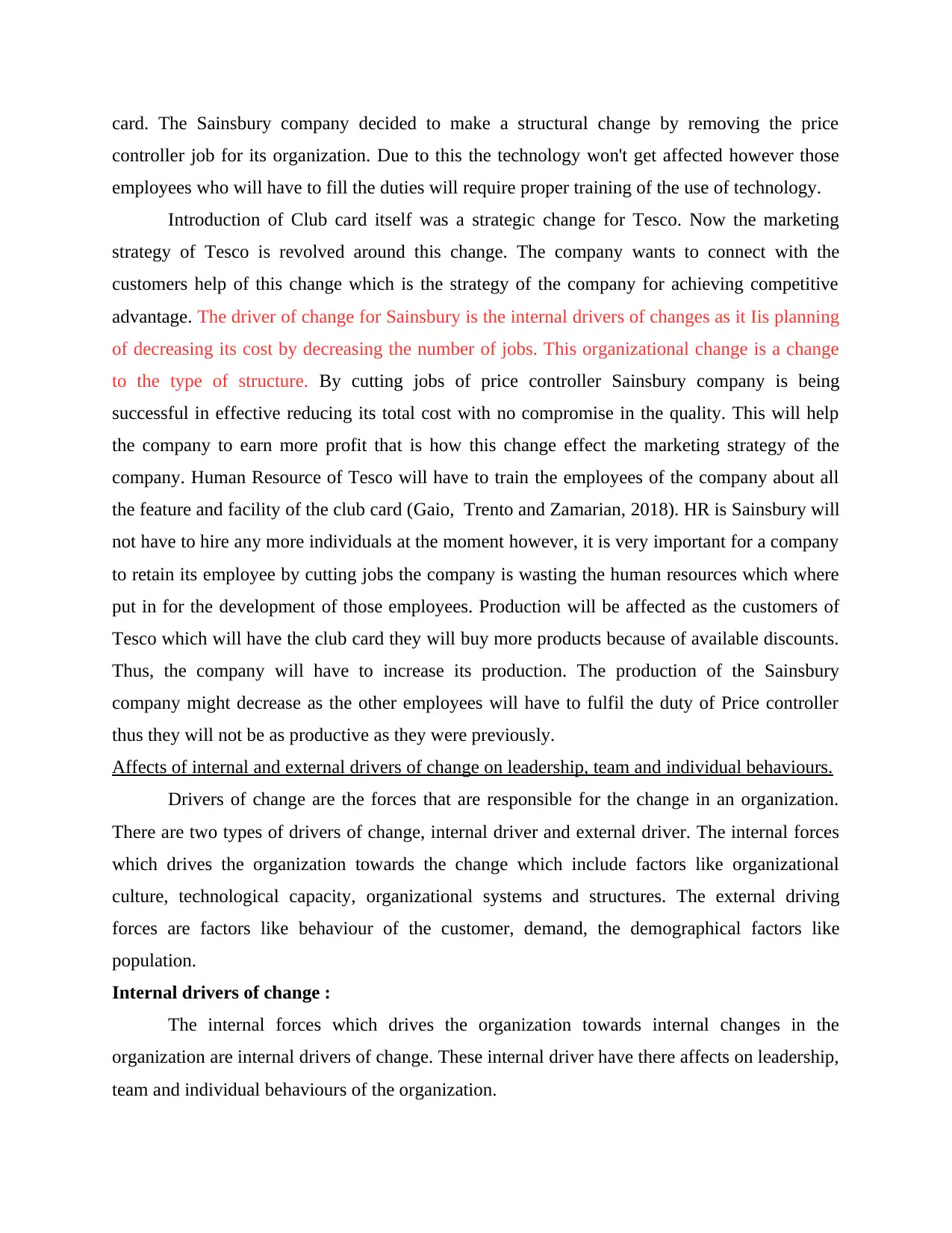
card. The Sainsbury company decided to make a structural change by removing the price
controller job for its organization. Due to this the technology won't get affected however those
employees who will have to fill the duties will require proper training of the use of technology.
Introduction of Club card itself was a strategic change for Tesco. Now the marketing
strategy of Tesco is revolved around this change. The company wants to connect with the
customers help of this change which is the strategy of the company for achieving competitive
advantage. The driver of change for Sainsbury is the internal drivers of changes as it Iis planning
of decreasing its cost by decreasing the number of jobs. This organizational change is a change
to the type of structure. By cutting jobs of price controller Sainsbury company is being
successful in effective reducing its total cost with no compromise in the quality. This will help
the company to earn more profit that is how this change effect the marketing strategy of the
company. Human Resource of Tesco will have to train the employees of the company about all
the feature and facility of the club card (Gaio, Trento and Zamarian, 2018). HR is Sainsbury will
not have to hire any more individuals at the moment however, it is very important for a company
to retain its employee by cutting jobs the company is wasting the human resources which where
put in for the development of those employees. Production will be affected as the customers of
Tesco which will have the club card they will buy more products because of available discounts.
Thus, the company will have to increase its production. The production of the Sainsbury
company might decrease as the other employees will have to fulfil the duty of Price controller
thus they will not be as productive as they were previously.
Affects of internal and external drivers of change on leadership, team and individual behaviours.
Drivers of change are the forces that are responsible for the change in an organization.
There are two types of drivers of change, internal driver and external driver. The internal forces
which drives the organization towards the change which include factors like organizational
culture, technological capacity, organizational systems and structures. The external driving
forces are factors like behaviour of the customer, demand, the demographical factors like
population.
Internal drivers of change :
The internal forces which drives the organization towards internal changes in the
organization are internal drivers of change. These internal driver have there affects on leadership,
team and individual behaviours of the organization.
controller job for its organization. Due to this the technology won't get affected however those
employees who will have to fill the duties will require proper training of the use of technology.
Introduction of Club card itself was a strategic change for Tesco. Now the marketing
strategy of Tesco is revolved around this change. The company wants to connect with the
customers help of this change which is the strategy of the company for achieving competitive
advantage. The driver of change for Sainsbury is the internal drivers of changes as it Iis planning
of decreasing its cost by decreasing the number of jobs. This organizational change is a change
to the type of structure. By cutting jobs of price controller Sainsbury company is being
successful in effective reducing its total cost with no compromise in the quality. This will help
the company to earn more profit that is how this change effect the marketing strategy of the
company. Human Resource of Tesco will have to train the employees of the company about all
the feature and facility of the club card (Gaio, Trento and Zamarian, 2018). HR is Sainsbury will
not have to hire any more individuals at the moment however, it is very important for a company
to retain its employee by cutting jobs the company is wasting the human resources which where
put in for the development of those employees. Production will be affected as the customers of
Tesco which will have the club card they will buy more products because of available discounts.
Thus, the company will have to increase its production. The production of the Sainsbury
company might decrease as the other employees will have to fulfil the duty of Price controller
thus they will not be as productive as they were previously.
Affects of internal and external drivers of change on leadership, team and individual behaviours.
Drivers of change are the forces that are responsible for the change in an organization.
There are two types of drivers of change, internal driver and external driver. The internal forces
which drives the organization towards the change which include factors like organizational
culture, technological capacity, organizational systems and structures. The external driving
forces are factors like behaviour of the customer, demand, the demographical factors like
population.
Internal drivers of change :
The internal forces which drives the organization towards internal changes in the
organization are internal drivers of change. These internal driver have there affects on leadership,
team and individual behaviours of the organization.
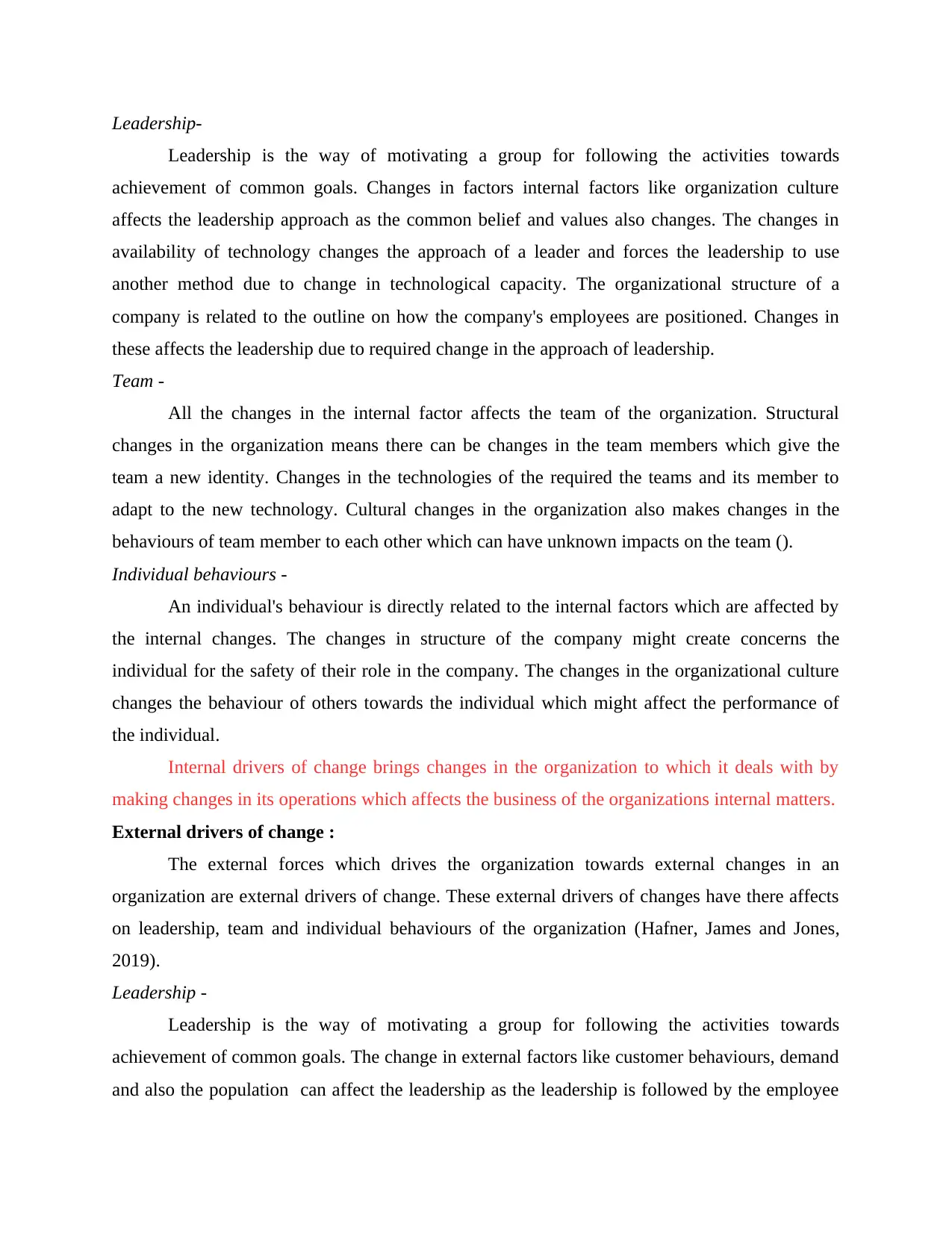
Leadership-
Leadership is the way of motivating a group for following the activities towards
achievement of common goals. Changes in factors internal factors like organization culture
affects the leadership approach as the common belief and values also changes. The changes in
availability of technology changes the approach of a leader and forces the leadership to use
another method due to change in technological capacity. The organizational structure of a
company is related to the outline on how the company's employees are positioned. Changes in
these affects the leadership due to required change in the approach of leadership.
Team -
All the changes in the internal factor affects the team of the organization. Structural
changes in the organization means there can be changes in the team members which give the
team a new identity. Changes in the technologies of the required the teams and its member to
adapt to the new technology. Cultural changes in the organization also makes changes in the
behaviours of team member to each other which can have unknown impacts on the team ().
Individual behaviours -
An individual's behaviour is directly related to the internal factors which are affected by
the internal changes. The changes in structure of the company might create concerns the
individual for the safety of their role in the company. The changes in the organizational culture
changes the behaviour of others towards the individual which might affect the performance of
the individual.
Internal drivers of change brings changes in the organization to which it deals with by
making changes in its operations which affects the business of the organizations internal matters.
External drivers of change :
The external forces which drives the organization towards external changes in an
organization are external drivers of change. These external drivers of changes have there affects
on leadership, team and individual behaviours of the organization (Hafner, James and Jones,
2019).
Leadership -
Leadership is the way of motivating a group for following the activities towards
achievement of common goals. The change in external factors like customer behaviours, demand
and also the population can affect the leadership as the leadership is followed by the employee
Leadership is the way of motivating a group for following the activities towards
achievement of common goals. Changes in factors internal factors like organization culture
affects the leadership approach as the common belief and values also changes. The changes in
availability of technology changes the approach of a leader and forces the leadership to use
another method due to change in technological capacity. The organizational structure of a
company is related to the outline on how the company's employees are positioned. Changes in
these affects the leadership due to required change in the approach of leadership.
Team -
All the changes in the internal factor affects the team of the organization. Structural
changes in the organization means there can be changes in the team members which give the
team a new identity. Changes in the technologies of the required the teams and its member to
adapt to the new technology. Cultural changes in the organization also makes changes in the
behaviours of team member to each other which can have unknown impacts on the team ().
Individual behaviours -
An individual's behaviour is directly related to the internal factors which are affected by
the internal changes. The changes in structure of the company might create concerns the
individual for the safety of their role in the company. The changes in the organizational culture
changes the behaviour of others towards the individual which might affect the performance of
the individual.
Internal drivers of change brings changes in the organization to which it deals with by
making changes in its operations which affects the business of the organizations internal matters.
External drivers of change :
The external forces which drives the organization towards external changes in an
organization are external drivers of change. These external drivers of changes have there affects
on leadership, team and individual behaviours of the organization (Hafner, James and Jones,
2019).
Leadership -
Leadership is the way of motivating a group for following the activities towards
achievement of common goals. The change in external factors like customer behaviours, demand
and also the population can affect the leadership as the leadership is followed by the employee
⊘ This is a preview!⊘
Do you want full access?
Subscribe today to unlock all pages.

Trusted by 1+ million students worldwide
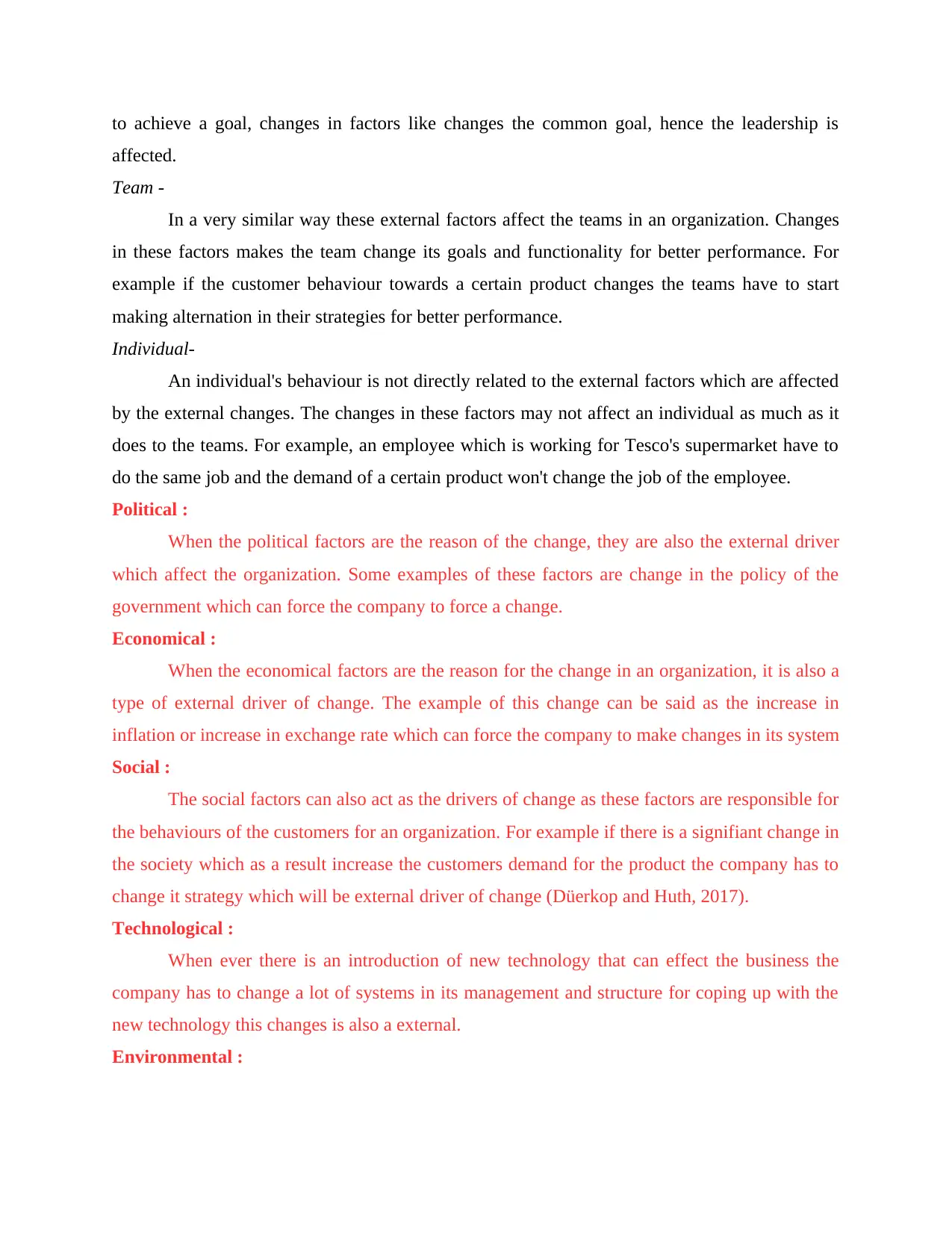
to achieve a goal, changes in factors like changes the common goal, hence the leadership is
affected.
Team -
In a very similar way these external factors affect the teams in an organization. Changes
in these factors makes the team change its goals and functionality for better performance. For
example if the customer behaviour towards a certain product changes the teams have to start
making alternation in their strategies for better performance.
Individual-
An individual's behaviour is not directly related to the external factors which are affected
by the external changes. The changes in these factors may not affect an individual as much as it
does to the teams. For example, an employee which is working for Tesco's supermarket have to
do the same job and the demand of a certain product won't change the job of the employee.
Political :
When the political factors are the reason of the change, they are also the external driver
which affect the organization. Some examples of these factors are change in the policy of the
government which can force the company to force a change.
Economical :
When the economical factors are the reason for the change in an organization, it is also a
type of external driver of change. The example of this change can be said as the increase in
inflation or increase in exchange rate which can force the company to make changes in its system
Social :
The social factors can also act as the drivers of change as these factors are responsible for
the behaviours of the customers for an organization. For example if there is a signifiant change in
the society which as a result increase the customers demand for the product the company has to
change it strategy which will be external driver of change (Düerkop and Huth, 2017).
Technological :
When ever there is an introduction of new technology that can effect the business the
company has to change a lot of systems in its management and structure for coping up with the
new technology this changes is also a external.
Environmental :
affected.
Team -
In a very similar way these external factors affect the teams in an organization. Changes
in these factors makes the team change its goals and functionality for better performance. For
example if the customer behaviour towards a certain product changes the teams have to start
making alternation in their strategies for better performance.
Individual-
An individual's behaviour is not directly related to the external factors which are affected
by the external changes. The changes in these factors may not affect an individual as much as it
does to the teams. For example, an employee which is working for Tesco's supermarket have to
do the same job and the demand of a certain product won't change the job of the employee.
Political :
When the political factors are the reason of the change, they are also the external driver
which affect the organization. Some examples of these factors are change in the policy of the
government which can force the company to force a change.
Economical :
When the economical factors are the reason for the change in an organization, it is also a
type of external driver of change. The example of this change can be said as the increase in
inflation or increase in exchange rate which can force the company to make changes in its system
Social :
The social factors can also act as the drivers of change as these factors are responsible for
the behaviours of the customers for an organization. For example if there is a signifiant change in
the society which as a result increase the customers demand for the product the company has to
change it strategy which will be external driver of change (Düerkop and Huth, 2017).
Technological :
When ever there is an introduction of new technology that can effect the business the
company has to change a lot of systems in its management and structure for coping up with the
new technology this changes is also a external.
Environmental :
Paraphrase This Document
Need a fresh take? Get an instant paraphrase of this document with our AI Paraphraser
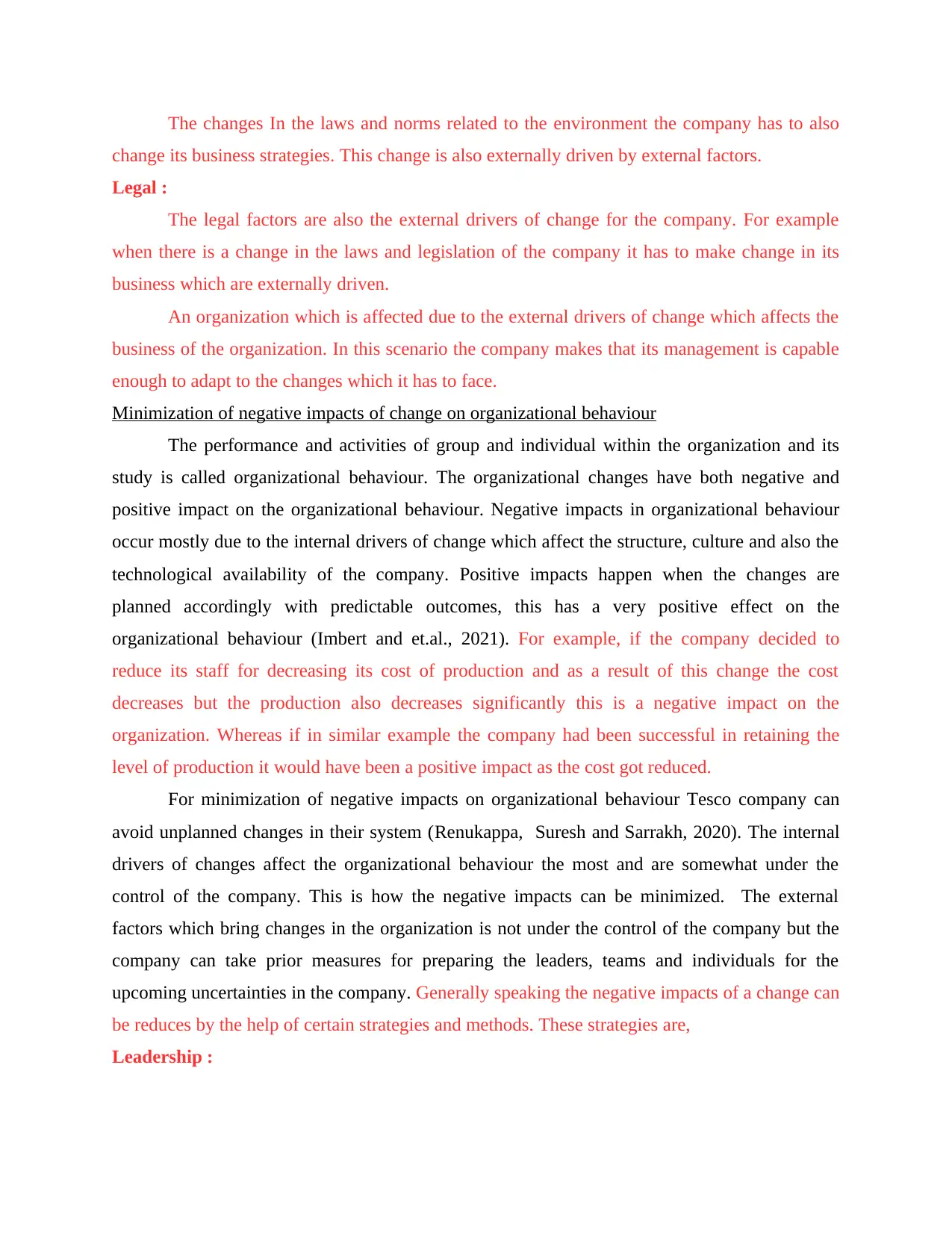
The changes In the laws and norms related to the environment the company has to also
change its business strategies. This change is also externally driven by external factors.
Legal :
The legal factors are also the external drivers of change for the company. For example
when there is a change in the laws and legislation of the company it has to make change in its
business which are externally driven.
An organization which is affected due to the external drivers of change which affects the
business of the organization. In this scenario the company makes that its management is capable
enough to adapt to the changes which it has to face.
Minimization of negative impacts of change on organizational behaviour
The performance and activities of group and individual within the organization and its
study is called organizational behaviour. The organizational changes have both negative and
positive impact on the organizational behaviour. Negative impacts in organizational behaviour
occur mostly due to the internal drivers of change which affect the structure, culture and also the
technological availability of the company. Positive impacts happen when the changes are
planned accordingly with predictable outcomes, this has a very positive effect on the
organizational behaviour (Imbert and et.al., 2021). For example, if the company decided to
reduce its staff for decreasing its cost of production and as a result of this change the cost
decreases but the production also decreases significantly this is a negative impact on the
organization. Whereas if in similar example the company had been successful in retaining the
level of production it would have been a positive impact as the cost got reduced.
For minimization of negative impacts on organizational behaviour Tesco company can
avoid unplanned changes in their system (Renukappa, Suresh and Sarrakh, 2020). The internal
drivers of changes affect the organizational behaviour the most and are somewhat under the
control of the company. This is how the negative impacts can be minimized. The external
factors which bring changes in the organization is not under the control of the company but the
company can take prior measures for preparing the leaders, teams and individuals for the
upcoming uncertainties in the company. Generally speaking the negative impacts of a change can
be reduces by the help of certain strategies and methods. These strategies are,
Leadership :
change its business strategies. This change is also externally driven by external factors.
Legal :
The legal factors are also the external drivers of change for the company. For example
when there is a change in the laws and legislation of the company it has to make change in its
business which are externally driven.
An organization which is affected due to the external drivers of change which affects the
business of the organization. In this scenario the company makes that its management is capable
enough to adapt to the changes which it has to face.
Minimization of negative impacts of change on organizational behaviour
The performance and activities of group and individual within the organization and its
study is called organizational behaviour. The organizational changes have both negative and
positive impact on the organizational behaviour. Negative impacts in organizational behaviour
occur mostly due to the internal drivers of change which affect the structure, culture and also the
technological availability of the company. Positive impacts happen when the changes are
planned accordingly with predictable outcomes, this has a very positive effect on the
organizational behaviour (Imbert and et.al., 2021). For example, if the company decided to
reduce its staff for decreasing its cost of production and as a result of this change the cost
decreases but the production also decreases significantly this is a negative impact on the
organization. Whereas if in similar example the company had been successful in retaining the
level of production it would have been a positive impact as the cost got reduced.
For minimization of negative impacts on organizational behaviour Tesco company can
avoid unplanned changes in their system (Renukappa, Suresh and Sarrakh, 2020). The internal
drivers of changes affect the organizational behaviour the most and are somewhat under the
control of the company. This is how the negative impacts can be minimized. The external
factors which bring changes in the organization is not under the control of the company but the
company can take prior measures for preparing the leaders, teams and individuals for the
upcoming uncertainties in the company. Generally speaking the negative impacts of a change can
be reduces by the help of certain strategies and methods. These strategies are,
Leadership :
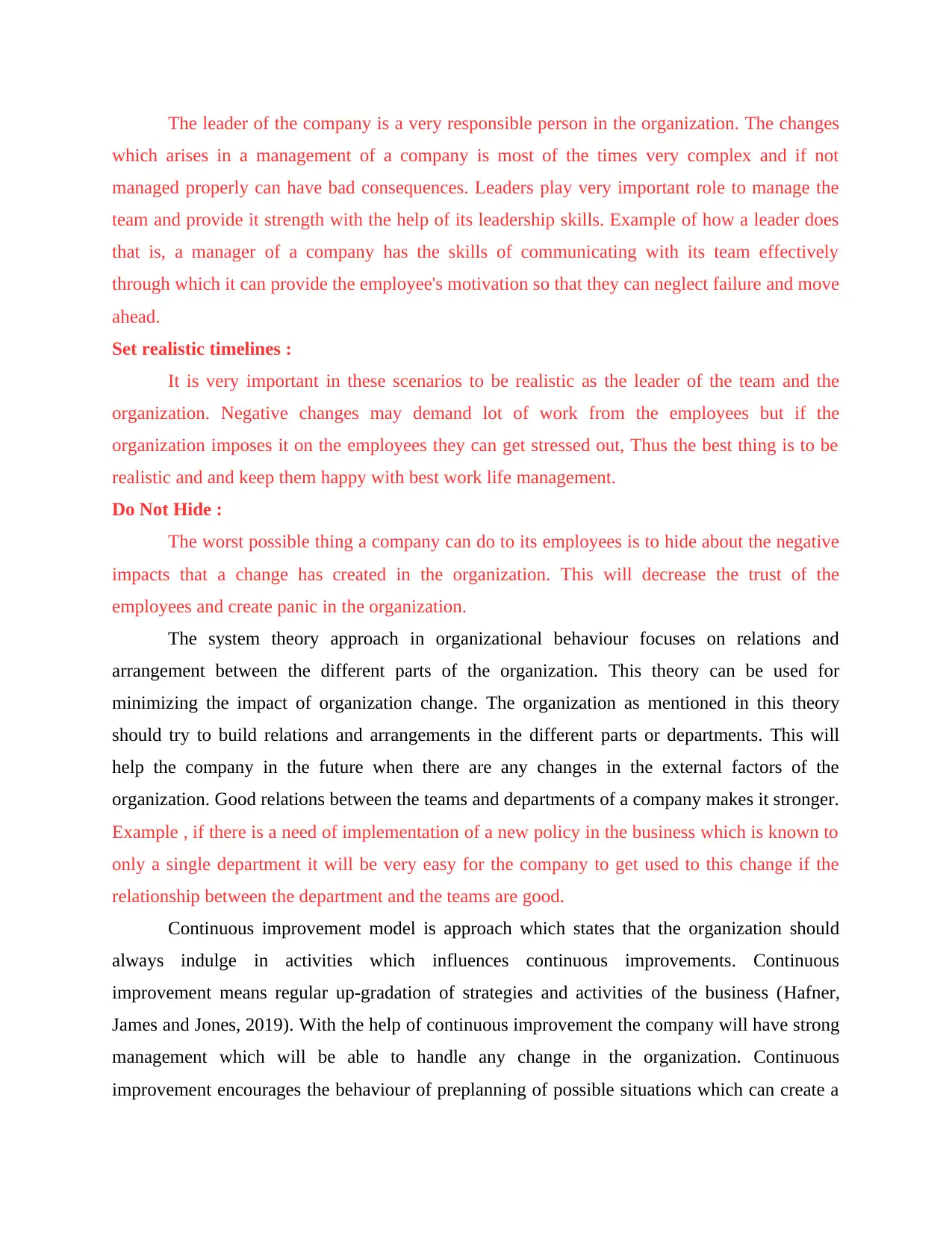
The leader of the company is a very responsible person in the organization. The changes
which arises in a management of a company is most of the times very complex and if not
managed properly can have bad consequences. Leaders play very important role to manage the
team and provide it strength with the help of its leadership skills. Example of how a leader does
that is, a manager of a company has the skills of communicating with its team effectively
through which it can provide the employee's motivation so that they can neglect failure and move
ahead.
Set realistic timelines :
It is very important in these scenarios to be realistic as the leader of the team and the
organization. Negative changes may demand lot of work from the employees but if the
organization imposes it on the employees they can get stressed out, Thus the best thing is to be
realistic and and keep them happy with best work life management.
Do Not Hide :
The worst possible thing a company can do to its employees is to hide about the negative
impacts that a change has created in the organization. This will decrease the trust of the
employees and create panic in the organization.
The system theory approach in organizational behaviour focuses on relations and
arrangement between the different parts of the organization. This theory can be used for
minimizing the impact of organization change. The organization as mentioned in this theory
should try to build relations and arrangements in the different parts or departments. This will
help the company in the future when there are any changes in the external factors of the
organization. Good relations between the teams and departments of a company makes it stronger.
Example , if there is a need of implementation of a new policy in the business which is known to
only a single department it will be very easy for the company to get used to this change if the
relationship between the department and the teams are good.
Continuous improvement model is approach which states that the organization should
always indulge in activities which influences continuous improvements. Continuous
improvement means regular up-gradation of strategies and activities of the business (Hafner,
James and Jones, 2019). With the help of continuous improvement the company will have strong
management which will be able to handle any change in the organization. Continuous
improvement encourages the behaviour of preplanning of possible situations which can create a
which arises in a management of a company is most of the times very complex and if not
managed properly can have bad consequences. Leaders play very important role to manage the
team and provide it strength with the help of its leadership skills. Example of how a leader does
that is, a manager of a company has the skills of communicating with its team effectively
through which it can provide the employee's motivation so that they can neglect failure and move
ahead.
Set realistic timelines :
It is very important in these scenarios to be realistic as the leader of the team and the
organization. Negative changes may demand lot of work from the employees but if the
organization imposes it on the employees they can get stressed out, Thus the best thing is to be
realistic and and keep them happy with best work life management.
Do Not Hide :
The worst possible thing a company can do to its employees is to hide about the negative
impacts that a change has created in the organization. This will decrease the trust of the
employees and create panic in the organization.
The system theory approach in organizational behaviour focuses on relations and
arrangement between the different parts of the organization. This theory can be used for
minimizing the impact of organization change. The organization as mentioned in this theory
should try to build relations and arrangements in the different parts or departments. This will
help the company in the future when there are any changes in the external factors of the
organization. Good relations between the teams and departments of a company makes it stronger.
Example , if there is a need of implementation of a new policy in the business which is known to
only a single department it will be very easy for the company to get used to this change if the
relationship between the department and the teams are good.
Continuous improvement model is approach which states that the organization should
always indulge in activities which influences continuous improvements. Continuous
improvement means regular up-gradation of strategies and activities of the business (Hafner,
James and Jones, 2019). With the help of continuous improvement the company will have strong
management which will be able to handle any change in the organization. Continuous
improvement encourages the behaviour of preplanning of possible situations which can create a
⊘ This is a preview!⊘
Do you want full access?
Subscribe today to unlock all pages.

Trusted by 1+ million students worldwide
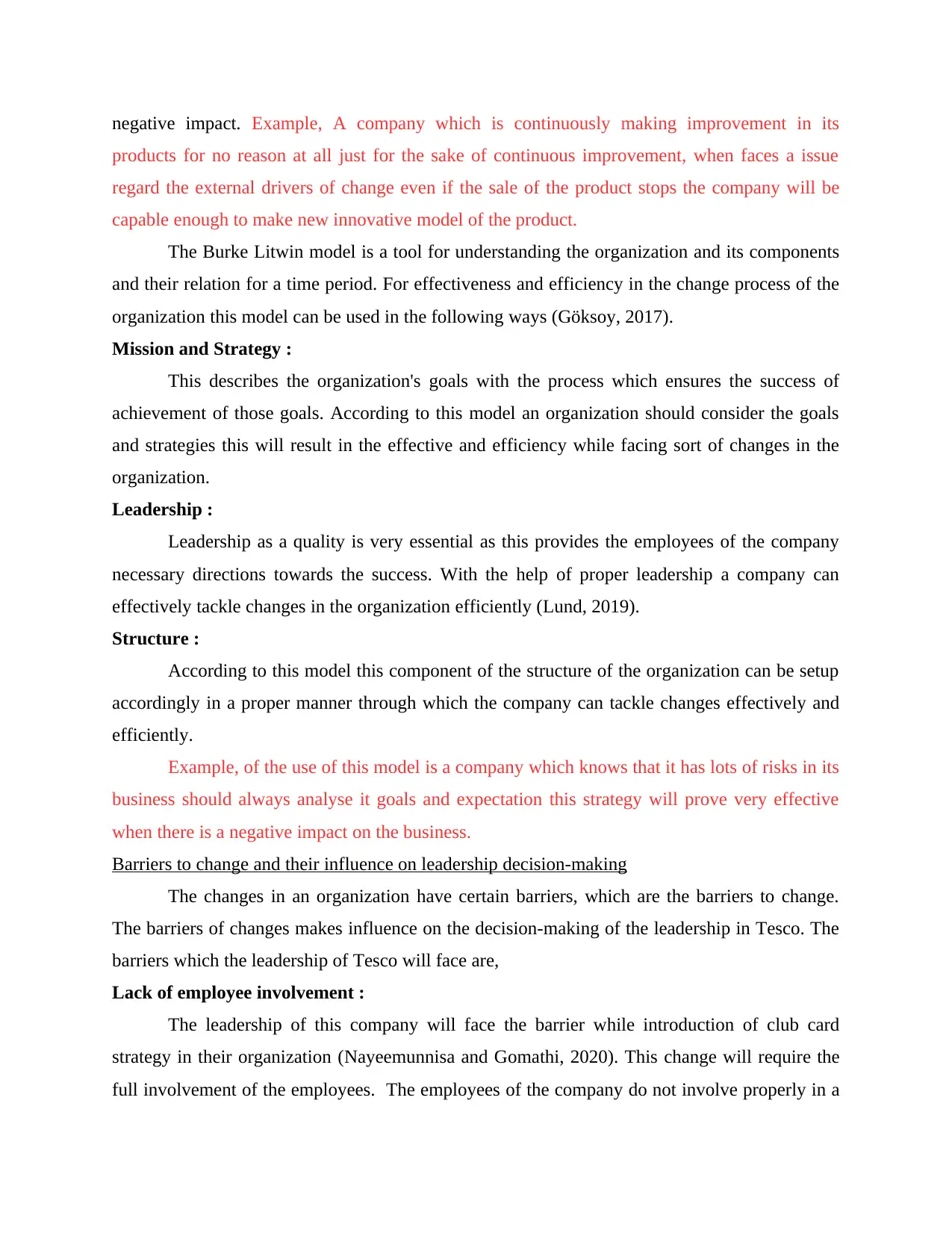
negative impact. Example, A company which is continuously making improvement in its
products for no reason at all just for the sake of continuous improvement, when faces a issue
regard the external drivers of change even if the sale of the product stops the company will be
capable enough to make new innovative model of the product.
The Burke Litwin model is a tool for understanding the organization and its components
and their relation for a time period. For effectiveness and efficiency in the change process of the
organization this model can be used in the following ways (Göksoy, 2017).
Mission and Strategy :
This describes the organization's goals with the process which ensures the success of
achievement of those goals. According to this model an organization should consider the goals
and strategies this will result in the effective and efficiency while facing sort of changes in the
organization.
Leadership :
Leadership as a quality is very essential as this provides the employees of the company
necessary directions towards the success. With the help of proper leadership a company can
effectively tackle changes in the organization efficiently (Lund, 2019).
Structure :
According to this model this component of the structure of the organization can be setup
accordingly in a proper manner through which the company can tackle changes effectively and
efficiently.
Example, of the use of this model is a company which knows that it has lots of risks in its
business should always analyse it goals and expectation this strategy will prove very effective
when there is a negative impact on the business.
Barriers to change and their influence on leadership decision-making
The changes in an organization have certain barriers, which are the barriers to change.
The barriers of changes makes influence on the decision-making of the leadership in Tesco. The
barriers which the leadership of Tesco will face are,
Lack of employee involvement :
The leadership of this company will face the barrier while introduction of club card
strategy in their organization (Nayeemunnisa and Gomathi, 2020). This change will require the
full involvement of the employees. The employees of the company do not involve properly in a
products for no reason at all just for the sake of continuous improvement, when faces a issue
regard the external drivers of change even if the sale of the product stops the company will be
capable enough to make new innovative model of the product.
The Burke Litwin model is a tool for understanding the organization and its components
and their relation for a time period. For effectiveness and efficiency in the change process of the
organization this model can be used in the following ways (Göksoy, 2017).
Mission and Strategy :
This describes the organization's goals with the process which ensures the success of
achievement of those goals. According to this model an organization should consider the goals
and strategies this will result in the effective and efficiency while facing sort of changes in the
organization.
Leadership :
Leadership as a quality is very essential as this provides the employees of the company
necessary directions towards the success. With the help of proper leadership a company can
effectively tackle changes in the organization efficiently (Lund, 2019).
Structure :
According to this model this component of the structure of the organization can be setup
accordingly in a proper manner through which the company can tackle changes effectively and
efficiently.
Example, of the use of this model is a company which knows that it has lots of risks in its
business should always analyse it goals and expectation this strategy will prove very effective
when there is a negative impact on the business.
Barriers to change and their influence on leadership decision-making
The changes in an organization have certain barriers, which are the barriers to change.
The barriers of changes makes influence on the decision-making of the leadership in Tesco. The
barriers which the leadership of Tesco will face are,
Lack of employee involvement :
The leadership of this company will face the barrier while introduction of club card
strategy in their organization (Nayeemunnisa and Gomathi, 2020). This change will require the
full involvement of the employees. The employees of the company do not involve properly in a
Paraphrase This Document
Need a fresh take? Get an instant paraphrase of this document with our AI Paraphraser
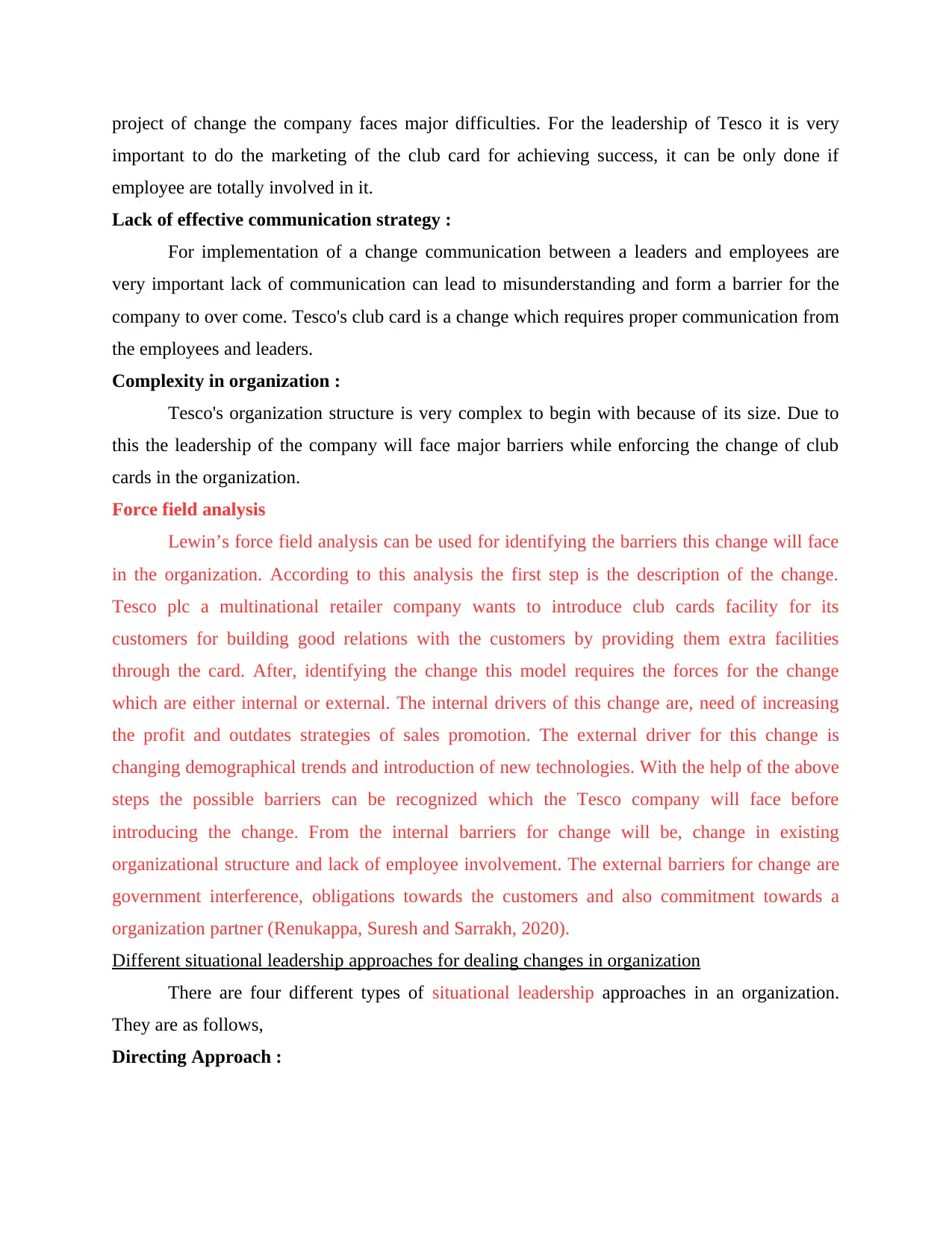
project of change the company faces major difficulties. For the leadership of Tesco it is very
important to do the marketing of the club card for achieving success, it can be only done if
employee are totally involved in it.
Lack of effective communication strategy :
For implementation of a change communication between a leaders and employees are
very important lack of communication can lead to misunderstanding and form a barrier for the
company to over come. Tesco's club card is a change which requires proper communication from
the employees and leaders.
Complexity in organization :
Tesco's organization structure is very complex to begin with because of its size. Due to
this the leadership of the company will face major barriers while enforcing the change of club
cards in the organization.
Force field analysis
Lewin’s force field analysis can be used for identifying the barriers this change will face
in the organization. According to this analysis the first step is the description of the change.
Tesco plc a multinational retailer company wants to introduce club cards facility for its
customers for building good relations with the customers by providing them extra facilities
through the card. After, identifying the change this model requires the forces for the change
which are either internal or external. The internal drivers of this change are, need of increasing
the profit and outdates strategies of sales promotion. The external driver for this change is
changing demographical trends and introduction of new technologies. With the help of the above
steps the possible barriers can be recognized which the Tesco company will face before
introducing the change. From the internal barriers for change will be, change in existing
organizational structure and lack of employee involvement. The external barriers for change are
government interference, obligations towards the customers and also commitment towards a
organization partner (Renukappa, Suresh and Sarrakh, 2020).
Different situational leadership approaches for dealing changes in organization
There are four different types of situational leadership approaches in an organization.
They are as follows,
Directing Approach :
important to do the marketing of the club card for achieving success, it can be only done if
employee are totally involved in it.
Lack of effective communication strategy :
For implementation of a change communication between a leaders and employees are
very important lack of communication can lead to misunderstanding and form a barrier for the
company to over come. Tesco's club card is a change which requires proper communication from
the employees and leaders.
Complexity in organization :
Tesco's organization structure is very complex to begin with because of its size. Due to
this the leadership of the company will face major barriers while enforcing the change of club
cards in the organization.
Force field analysis
Lewin’s force field analysis can be used for identifying the barriers this change will face
in the organization. According to this analysis the first step is the description of the change.
Tesco plc a multinational retailer company wants to introduce club cards facility for its
customers for building good relations with the customers by providing them extra facilities
through the card. After, identifying the change this model requires the forces for the change
which are either internal or external. The internal drivers of this change are, need of increasing
the profit and outdates strategies of sales promotion. The external driver for this change is
changing demographical trends and introduction of new technologies. With the help of the above
steps the possible barriers can be recognized which the Tesco company will face before
introducing the change. From the internal barriers for change will be, change in existing
organizational structure and lack of employee involvement. The external barriers for change are
government interference, obligations towards the customers and also commitment towards a
organization partner (Renukappa, Suresh and Sarrakh, 2020).
Different situational leadership approaches for dealing changes in organization
There are four different types of situational leadership approaches in an organization.
They are as follows,
Directing Approach :
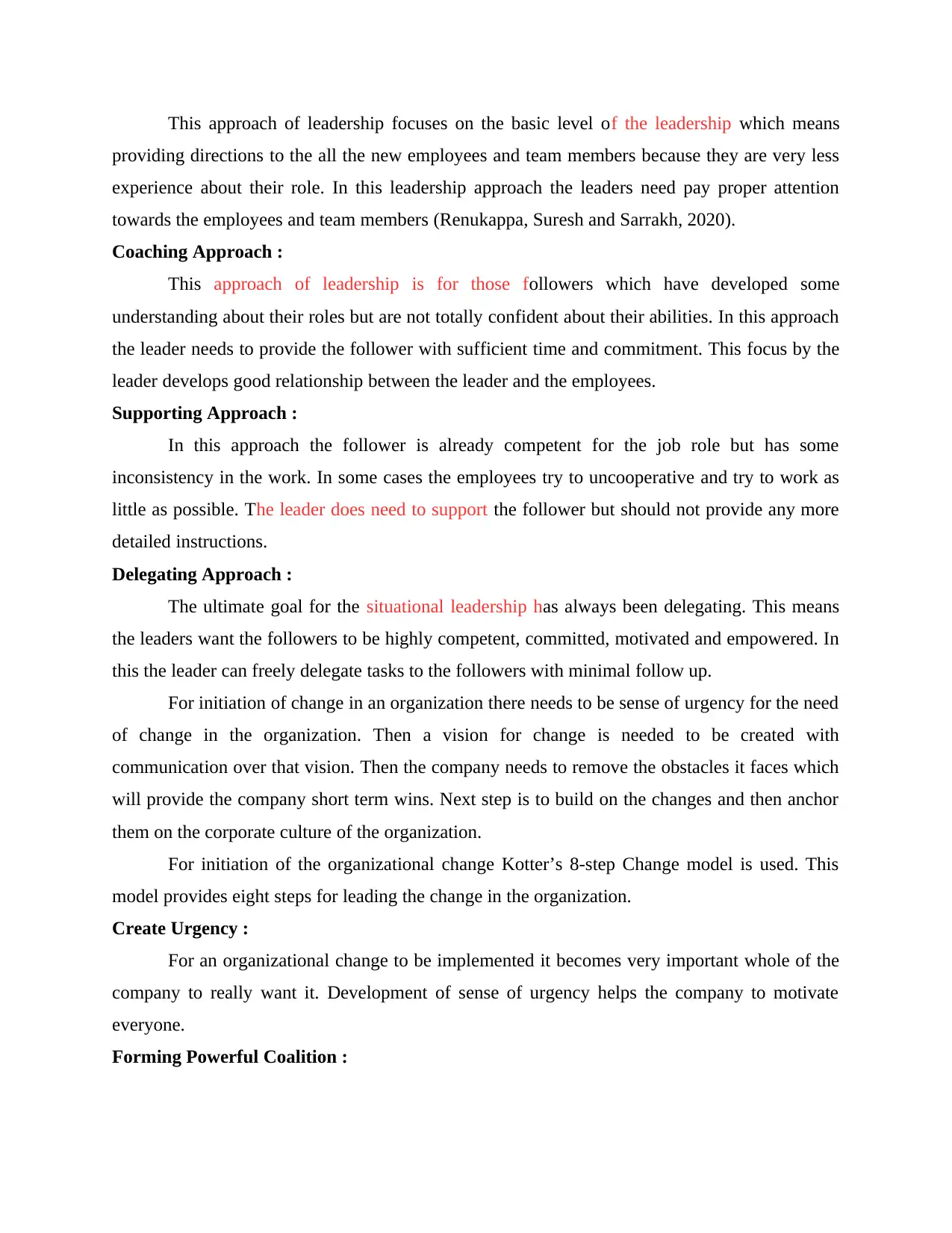
This approach of leadership focuses on the basic level of the leadership which means
providing directions to the all the new employees and team members because they are very less
experience about their role. In this leadership approach the leaders need pay proper attention
towards the employees and team members (Renukappa, Suresh and Sarrakh, 2020).
Coaching Approach :
This approach of leadership is for those followers which have developed some
understanding about their roles but are not totally confident about their abilities. In this approach
the leader needs to provide the follower with sufficient time and commitment. This focus by the
leader develops good relationship between the leader and the employees.
Supporting Approach :
In this approach the follower is already competent for the job role but has some
inconsistency in the work. In some cases the employees try to uncooperative and try to work as
little as possible. The leader does need to support the follower but should not provide any more
detailed instructions.
Delegating Approach :
The ultimate goal for the situational leadership has always been delegating. This means
the leaders want the followers to be highly competent, committed, motivated and empowered. In
this the leader can freely delegate tasks to the followers with minimal follow up.
For initiation of change in an organization there needs to be sense of urgency for the need
of change in the organization. Then a vision for change is needed to be created with
communication over that vision. Then the company needs to remove the obstacles it faces which
will provide the company short term wins. Next step is to build on the changes and then anchor
them on the corporate culture of the organization.
For initiation of the organizational change Kotter’s 8-step Change model is used. This
model provides eight steps for leading the change in the organization.
Create Urgency :
For an organizational change to be implemented it becomes very important whole of the
company to really want it. Development of sense of urgency helps the company to motivate
everyone.
Forming Powerful Coalition :
providing directions to the all the new employees and team members because they are very less
experience about their role. In this leadership approach the leaders need pay proper attention
towards the employees and team members (Renukappa, Suresh and Sarrakh, 2020).
Coaching Approach :
This approach of leadership is for those followers which have developed some
understanding about their roles but are not totally confident about their abilities. In this approach
the leader needs to provide the follower with sufficient time and commitment. This focus by the
leader develops good relationship between the leader and the employees.
Supporting Approach :
In this approach the follower is already competent for the job role but has some
inconsistency in the work. In some cases the employees try to uncooperative and try to work as
little as possible. The leader does need to support the follower but should not provide any more
detailed instructions.
Delegating Approach :
The ultimate goal for the situational leadership has always been delegating. This means
the leaders want the followers to be highly competent, committed, motivated and empowered. In
this the leader can freely delegate tasks to the followers with minimal follow up.
For initiation of change in an organization there needs to be sense of urgency for the need
of change in the organization. Then a vision for change is needed to be created with
communication over that vision. Then the company needs to remove the obstacles it faces which
will provide the company short term wins. Next step is to build on the changes and then anchor
them on the corporate culture of the organization.
For initiation of the organizational change Kotter’s 8-step Change model is used. This
model provides eight steps for leading the change in the organization.
Create Urgency :
For an organizational change to be implemented it becomes very important whole of the
company to really want it. Development of sense of urgency helps the company to motivate
everyone.
Forming Powerful Coalition :
⊘ This is a preview!⊘
Do you want full access?
Subscribe today to unlock all pages.

Trusted by 1+ million students worldwide
1 out of 16
Related Documents
Your All-in-One AI-Powered Toolkit for Academic Success.
+13062052269
info@desklib.com
Available 24*7 on WhatsApp / Email
![[object Object]](/_next/static/media/star-bottom.7253800d.svg)
Unlock your academic potential
Copyright © 2020–2025 A2Z Services. All Rights Reserved. Developed and managed by ZUCOL.




